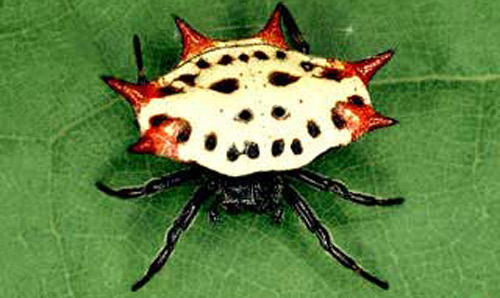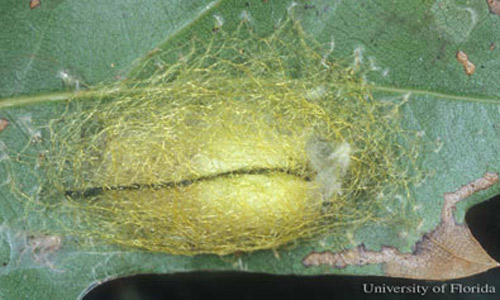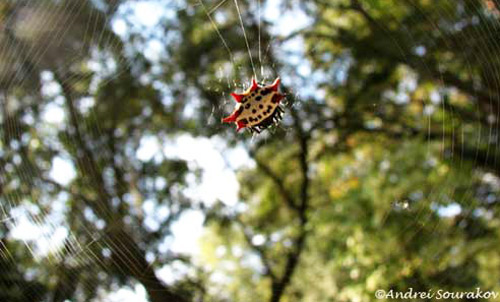common name: spinybacked orbweaver
scientific name: Gasteracantha cancriformis (Linnaeus) (Arachnida: Araneae: Araneidae)
Introduction - Systematics - Distribution - Identification - Biology - Survey and Detection - Selected References
Introduction (Back to Top)
One of the more colorful spiders in Florida is the spinybacked orbweaver, Gasteracantha cancriformis (Linnaeus) 1767. Although not as large as some of the other common orb weavers (e.g., Argiope, Levi 1968; Neoscona, Edwards 1984), the combination of color, shape, and web characteristics make Gasteracantha cancriformis one of the most conspicuous of spiders. The colloquial name for this spider in parts of Florida is crab spider, although it is not related to any of the families of spiders commonly called crab spiders, e.g., Thomisidoe.
Figure 1. The spinybacked orbweaver, Gasteracantha cancriformis (Linnaeus), in its web. Photograph by Andrei Sourakov, Florida Museum of Natural History.
Systematics (Back to Top)
Because of the variations in color and shape of the abdominal "spines" throughout its range, Gasteracantha cancriformis has been described by numerous early scientists under a plethora of names (Levi 1978). Although Kaston (1978) continued the use of the name Gasteracantha elipsoides (Walckenaer) 1841, resurrected by Chamberlin and Ivie (1944), Levi (1978) examined this species and found it to be a synonym of Gasteracantha cancriformis.
Distribution (Back to Top)
This species belongs to a pantropical genus which contains many species in the Old World. With the possible exception of the West Indian Gasteracantha tetracantha (L.) (which may be only a geographic race), Gasteracantha cancriformis is the only species of its genus to occur in the New World, ranging from the southern United States to northern Argentina (Levi 1978).
Identification (Back to Top)
This species can be easily distinguished from all other spiders in Florida. Females may be 5 to nearly 9 mm in length, but 10 to 13 mm wide. They have six pointed abdominal projections frequently referred to as "spines." The carapace, legs, and venter are black, with some white spots on the underside of the abdomen. The dorsum of the abdomen is, typically for Florida specimens, white with black spots and red spines. Specimens from other areas may have the abdominal dorsum yellow instead of white, may have black spines instead of red, or may be almost entirely black dorsally and ventrally. Males are much smaller than females, 2 to 3 mm long, and slightly longer than wide. Color is similar to the female, except the abdomen is gray with white spots. The large abdominal spines are lacking, although there are four or five posterior small humps (Levi 1978, Muma 1971).
Figure 2. Female spinybacked orbweaver, Gasteracantha cancriformis (Linnaeus). Photograph by University of Florida.
Biology (Back to Top)
Muma (1971) discussed the life cycle and web construction of Gasteracantha cancriformis in Florida. Although males have been found in every month except December and January (Levi 1978), they are most common in October and November. Females, which are found as adults throughout the year, are most common from October through January. Mixed-mesophytic woodlands and citrus groves are where they are most frequently found. Males hang by single threads from the females' webs prior to mating, described by Muma (1971).
Ovate egg sacs, 20 to 25 mm long by 10 to 15 mm wide, are deposited on the undersides of leaves adjacent to the female's web from October through January. The egg mass consists of 101 to 256 eggs, with a mean of 169 (based on 15 egg masses). After the eggs are laid on a white silken sheet, they are first covered with a loose, tangled mass of fine white or yellowish silk, then several strands of dark green silk are laid along the longitudinal axis of the egg mass, followed by a net-like canopy of coarse green and yellow threads. Eggs are frequently attacked by specialized predators, primarily Phalacrotophora epeirae (Brues) (Diptera: Phoridae), and occasionally Arachnophago ferruginea Gahan (Hymenoptera: Eupelmidae) (Muma and Stone 1971). Eggs take 11 to 13 days to hatch, then spend two to three days in a pink and white deutova stage before molting to the first instar.
Figure 3. Egg sac of the spinybacked orbweaver, Gasteracantha cancriformis (Linnaeus). Photograph by Lyle J. Buss, University of Florida.
After another five to seven days, the spiderlings acquire dark coloration. Spiderlings dispersed within a week later in disturbed laboratory colonies, but remained in the eggsacs an additional two to five weeks in the field. Spiderlings make tiny, inconspicious orb webs or hang from single strands. In the late summer and early fall, significant increases occur in both body and web size. The larger webs have 10 to 30 radii. The central disk where the spider rests is separated from the sticky (viscid) spirals by an open area 4 to 8 cm wide. There may be as many as 30 loops of the viscid spiral, spaced at 2 to 4 mm intervals. The catching area of the web may be 30 to 60 cm in diameter. Conspicuous tufts of silk occur on the web, primarily on the foundation lines. The function of these tufts is unknown, but one hypothesis suggests that the tufts make the webs more conspicuous to birds (Eisner and Nowicki 1983), preventing the birds from flying into and destroying the webs. The webs may be less than 1 m to more than 6 m above ground. The spiders prey on whiteflies, flies, moths, and beetles that are caught in the webs.
Figure 4. The spinybacked orbweaver, Gasteracantha cancriformis (Linnaeus), in its web. Photograph by Andrei Sourakov, Florida Museum of Natural History.
Survey and Detection (Back to Top)
Citrus workers frequently encounter this species, and it may occur on trees and shrubs around houses and nurseries. Specimens may be easily collected in small vials, and are best preserved, as are all spiders, in 70 to 80% ethyl or isopropyl alcohol.
The bite of this common species is not known to cause serious effects to humans.
Selected References (Back to Top)
- Chamberlin RV, Ivie W. 1944. Spiders of the Georgia region of North America. Bulletin of the University of Utah 35: 1-267.
- Edwards GB. 1984. Large Florida orb weavers of the genus Neoscona (Araneae: Araneidae). Florida Department of Agriculture and Consumer Services, Division of Plant Industry Entomology Circular 266: 1-2.
- Eisner T, Nowicki S. 1983. Spider web protection through visual advertisement: Role of the stabilimentum. Science 219: 185-187.
- Kaston BJ. 1978. How to Know the Spiders. 3rd ed. Wm. C. Brown Co., Dubuque, Iowa. 272 pp.
- Levi HW. 1968. The spider genera Gea and Argiope in America (Araneae: Araneidae). Bulletin of the Museum of Comparative Zoology 136: 319-352.
- Levi HW. 1978. The American orb-weaver genera Colphepeira, Microtheno and Gasteracantha North of Mexico. Bulletin of the Museum of Comparative Zoology 148: 417-442.
- Muma MH. 1971. Biological and behavioral notes on Gasteracantha cancriformis (Arachnida: Araneidae). Florida Entomologist 54: 345-351.
- Muma MH, Stone KJ. 1971. Predation of Gasteracantha cancriformis (Arachnida: Araneidae) eggs in Florida citrus groves by Phalacrotophora epeirae (Insecta: Phoridae) and Arachnophaga ferruginea (Insecta: Eupelmidae). Florida Entomologist 54: 305-310.



